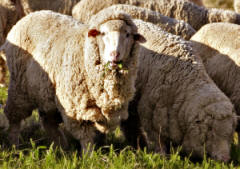|
| |

merino sheep
Only years of experience
will give you the ability to recognize quality when it comes to cloth. A great
cloth will give everything to a garment. In my opinion, today the English still
make the finest woolens in the world and they are well worth the price. Ship
to us directly from stocks in England or Europe and save.
We keep a small "in
stock" selection of cloth that we include with our price. We strongly
suggest that you build your own inventory of cloth with us. This will
give you speedy production times as well as a remarkably well priced garment
made with the finest English and Italian cloth.
The following is some information which may be
helpful in your understanding of cloth. There are many misconceptions even
amongst tailors and professionals as to what is what.
-
- Merino wool
... the preferred breed of sheep, and the most numerous in the world.
Regarded as having the finest and softest wool of any sheep. fleece is
generally less than 24.5 microns in diameter. Medium merino wool is
between 20.6-22.5 µm, fine medium is between 19.6-20.5 µm, fine is between
18.6-19.5 µm, superfine is between 17.6-18.5 and ultra fine wool is between
12.5 to 16.9. Ultra fine wool is suitable for blending with other
exclusive fibers such as silk and cashmere.
-
- Cashmere ...
a word used for the fibers found on the under belly of a goat, and more
commonly expected to be of a particular breed the Cashmere goat
(Asiatic Falconeri) also known as Pashmina. Found mostly in Mongolia,
and the Middle East. Producing an extra fine fiber of less than 19 microns.
The name derives from an archaic spelling of Kashmir. It is sometimes
incorrectly applied to any extremely soft wool regardless of origin.
-
- Super 100's
... no one knows where the "super" classification came from, but it
its believed that some English wool distributor first used it in the 1970's
as a selling point. At the time, the grading system for wool went only
up to 90's, the 100's classification was introduced as a marketing tool.
As the years have gone by, we now have 110's, 120's ...and most
recently, we have seen a supplier marketing a super 200's touted to be
of fibers of 13 microns. Yet some of these fabrics are made so
thin that they don't wear well and tear easily. Unfortunately, since
there is no authority that will assure standards for these classifications,
we suggest you rely on the knowledge of professional master tailors and your
own good sense when making fabric selections. You can rest assured
that the cloth we select for our clothes are carefully selected for not only
the quality of fiber but also weave and consistency.
-
- Rayon
... is produced from naturally occurring polymers and therefore it is not a
synthetic fiber, but a manufactured regenerated cellulosic fiber. It
is the fiber which Bemberg lining is made from. This is the lining that is
universally preferred by tailors. Silk is rarely used as it dose not handle
or wear as well.
-
Eye of the rock
a recent expression for individually cutting the cloth.
Prior to the 1900's patterns were not in use. Tailors would use a
T square and plot a graph directly onto the cloth using the customers
measurements. they would use a rock (chalk) to draw lines from the points
they had plotted onto the cloth to make a pattern directly on to the cloth.
-
-
-
Maximum
fiber diameter in Microns
Super
80’s 19.5 micron
Super 100’s 18.5 micron
Super 120’s 17.5 micron
Super 130’s 16.5 micron
Super 140’s 16 micron
Super 150’s 15.5 micron
Super 180’s 13.5 micron
Super 200’s 13 micron
-
-
|
